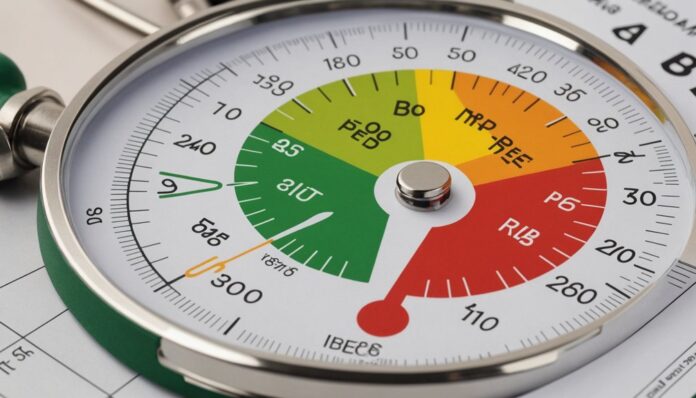Blood pressure categories are a vital aspect of understanding cardiovascular health risks. The American Heart Association defines several categories, ranging from normal to various stages of hypertension. Each category corresponds to a specific blood pressure range and level of risk. Understanding these categories is fundamental for identifying potential health issues and taking timely action. A closer examination of these categories and their associated risks reveals the importance of monitoring and managing blood pressure.
Highlights
- The American Heart Association defines blood pressure categories based on systolic and diastolic levels to diagnose, treat, and manage hypertension.
- Normal blood pressure is < 120/80 mmHg, elevated is 120-129/< 80 mmHg, and hypertension is ≥ 130/80 mmHg or higher.
- Hypertension stages include Stage 1 (130-139/80-89 mmHg) and Stage 2 (≥ 140/90 mmHg), with varying risks of cardiovascular disease.
- Regular blood pressure checks are crucial for individuals with high blood pressure and even those with normal blood pressure to ensure control and early detection.
- Uncontrolled hypertension can lead to severe health complications, including heart disease, stroke, and kidney damage, emphasizing the importance of early detection and management.
What Are Blood Pressure Categories
When monitoring and managing blood pressure, understanding the various categories is fundamental for healthcare professionals and individuals alike. Blood pressure categories provide a standardized structure for interpreting blood pressure readings, enabling healthcare providers to diagnose, treat, and manage hypertension effectively.
The American Heart Association defines blood pressure categories based on systolic and diastolic pressure levels. Accurate measurement techniques are essential in determining blood pressure categories, and standardized protocols guarantee consistent results.
Blood pressure definitions take into account various factors, such as age, health status, and medication usage. By recognizing the different categories, healthcare professionals and individuals can work together to prevent, manage, and control blood pressure, ultimately reducing the risk of cardiovascular disease and other complications.
Blood pressure categories serve as an important tool in understanding and addressing blood pressure-related health issues.
Understanding Blood Pressure Readings
Blood pressure readings are the foundation of determining an individual’s blood pressure category. To understand blood pressure readings, it’s important to familiarize oneself with blood pressure terminology.
Systolic pressure refers to the top number, representing the pressure exerted on the arteries when the heart beats. Diastolic pressure is the bottom number, representing the pressure between beats.
Blood pressure factors, such as lifestyle, genetics, and health conditions, can influence readings. Accurate measurements are essential, typically taken by a healthcare professional using a sphygmomanometer. Automated devices can also provide reliable readings.
Understanding blood pressure readings enables individuals to take control of their cardiovascular health and make informed decisions about managing blood pressure factors to mitigate potential risks. This knowledge is crucial for maintaining overall well-being.
Normal Blood Pressure Range
A healthy cardiovascular system is characterized by a blood pressure reading that falls within a normal range. For adults, a normal blood pressure range is typically defined as a systolic pressure of less than 120 mmHg and a diastolic pressure of less than 80 mmHg.
This range is associated with a lower risk of cardiovascular disease and stroke. Maintaining a normal blood pressure is essential for overall health, as high blood pressure can lead to serious complications.
Blood pressure within the normal range indicates that the heart is pumping efficiently and blood vessels are flexible and able to expand and contract as needed. Monitoring blood pressure regularly can help individuals identify potential issues early on and take steps to maintain a healthy blood pressure.
Elevated Blood Pressure Explained
Individuals with a systolic pressure of 120-129 mmHg and a diastolic pressure below 80 mmHg are classified as having raised blood pressure. This category is often referred to as heightened blood pressure.
Heightened readings indicate a potential risk for future health problems. Individuals with heightened blood pressure are more likely to develop cardiovascular disease, kidney disease, and stroke compared to those with normal blood pressure.
The health implications of heightened blood pressure are significant, emphasizing the importance of lifestyle modifications and regular monitoring to prevent further increases in blood pressure.
Early detection and intervention can help mitigate these risks, making it essential for individuals to work closely with their healthcare provider to manage their blood pressure and prevent long-term damage.
Stage 1 Hypertension Causes And Risks
Typically, people with a systolic pressure of 130-139 mmHg or a diastolic pressure of 80-89 mmHg are classified as having Stage 1 hypertension.
At this stage, it is vital to identify potential hypertension triggers to mitigate the risk of cardiovascular disease. Research suggests that genetic factors play a significant role in the development of hypertension, and individuals with a family history of hypertension are more likely to develop it.
Other contributing factors include an unhealthy diet, inadequate physical activity, and excessive sodium intake. If left unmanaged, Stage 1 hypertension can progress to more severe stages, increasing the risk of heart failure, stroke, and kidney disease.
Recognizing and addressing these risk factors is essential to prevent further complications. Effective management of Stage 1 hypertension can be achieved through lifestyle modifications and, if necessary, medication.
Stage 2 Hypertension Symptoms And Treatment
People with Stage 1 hypertension who do not receive timely and effective treatment may progress to Stage 2 hypertension, characterized by a systolic pressure of 140 mmHg or higher or a diastolic pressure of 90 mmHg or higher.
At this stage, the risk of cardiovascular disease and stroke increases considerably. Stage 2 symptoms may include headaches, dizziness, and shortness of breath. However, some individuals may not exhibit noticeable symptoms until the condition has advanced.
Treatment options typically involve lifestyle modifications and medication. Medications may include diuretics, beta-blockers, and ACE inhibitors.
It is essential to work closely with a healthcare provider to determine the most effective treatment plan. With proper treatment and management, individuals with Stage 2 hypertension can reduce their risk of complications and improve their overall health.
Lifestyle Changes To Lower Blood Pressure
How can one effectively manage high blood pressure without relying solely on medication?
Lifestyle modifications play an essential role in lowering blood pressure and reducing the risk of cardiovascular disease. Dietary changes, such as increasing potassium and fiber intake, can help lower blood pressure.
Regular exercise routines, including aerobic exercises and strength training, can also contribute to blood pressure reduction.
Stress management techniques, like meditation and deep breathing, can help mitigate the negative effects of stress on blood pressure.
Additionally, sleep improvements, alcohol reduction, and smoking cessation can also contribute to lower blood pressure.
By incorporating these lifestyle changes, individuals can effectively manage their blood pressure and reduce their risk of cardiovascular disease.
These changes can be customized to an individual’s specific needs and goals.
Managing High Blood Pressure With Medication
Managing high blood pressure with medication requires a thorough approach that involves careful consideration of the type and dosage of medication, as well as ongoing monitoring of blood pressure levels.
Medication adherence is vital for effective blood pressure management. Patients must work closely with their healthcare provider to find the right medication and dosage, and to monitor potential side effects.
The goal is to achieve and maintain a healthy blood pressure range, reducing the risk of complications. Various medications are available, including diuretics, beta blockers, and ACE inhibitors.
Each type of medication has its own benefits and potential side effects, underscoring the need for regular consultations with a healthcare provider. By working together, patients can successfully manage their high blood pressure with medication.
The Importance Of Regular Blood Pressure Checks
Because high blood pressure often presents no noticeable symptoms, regular blood pressure checks are vital for detecting and monitoring the condition.
Regular monitoring helps identify potential issues before they become severe. Blood pressure awareness is a critical aspect of maintaining cardiovascular health.
Individuals with high blood pressure need regular checks to confirm their condition is under control. Even those with normal blood pressure should have it checked regularly to catch any potential problems early on.
Healthcare providers recommend regular blood pressure checks for adults of all ages.
By prioritizing blood pressure awareness, individuals can better understand their unique situation and take proactive steps to maintain ideal blood pressure.
Regular checks enable individuals to make informed decisions about their health.
Reducing The Risk Of Complications From Hypertension
Lowering blood pressure through lifestyle changes and, when necessary, medication is vital for reducing the risk of complications from hypertension.
By making dietary modifications, such as consuming a balanced diet low in sodium, fat, and cholesterol, individuals can effectively manage their blood pressure. Regular physical activity and maintaining a healthy weight are also essential in reducing the risk of hypertension-related complications.
Stress management techniques, such as meditation and deep breathing, can also help alleviate the negative effects of stress on blood pressure.
Conclusion
Regular monitoring of blood pressure is essential for detecting potential cardiovascular health risks. Understanding blood pressure categories enables individuals to make informed decisions about their health. By adopting healthy lifestyle habits and seeking medical intervention when necessary, individuals can effectively manage their blood pressure levels. Early detection and treatment can help reduce the risk of complications from hypertension, ultimately promoting ideal cardiovascular health. A proactive approach to blood pressure management is key to maintaining overall well-being.


